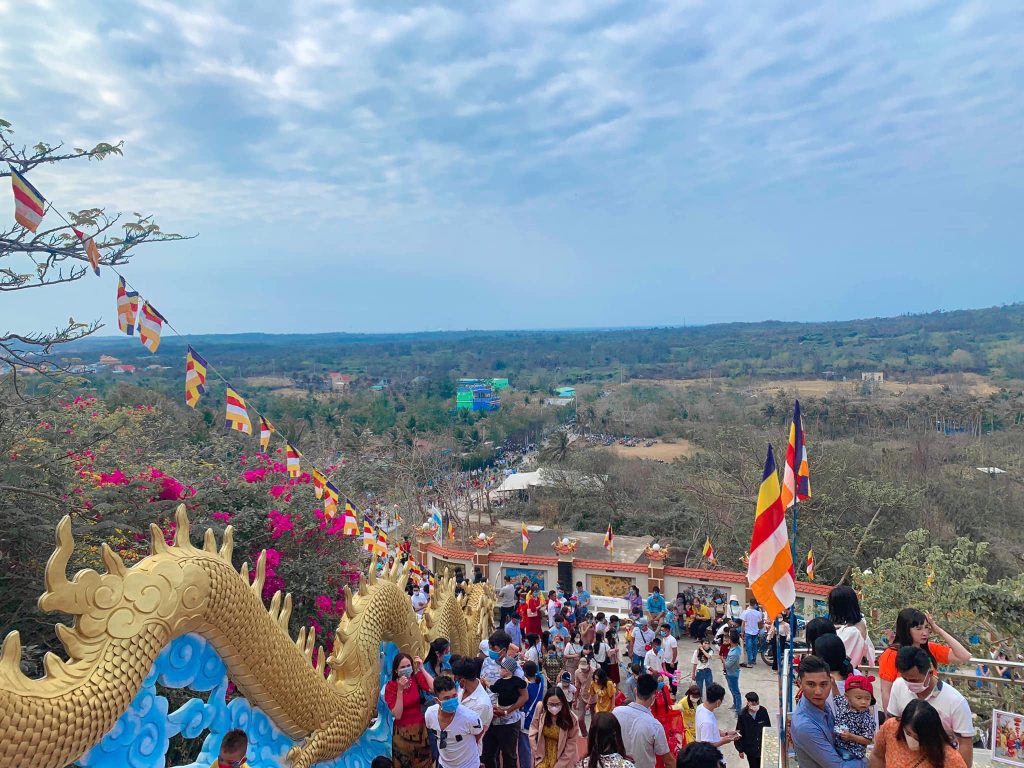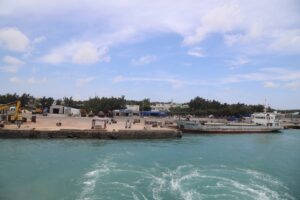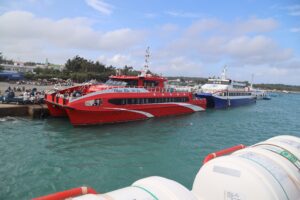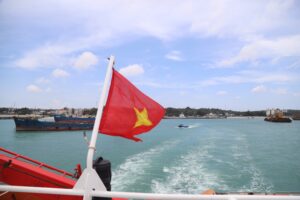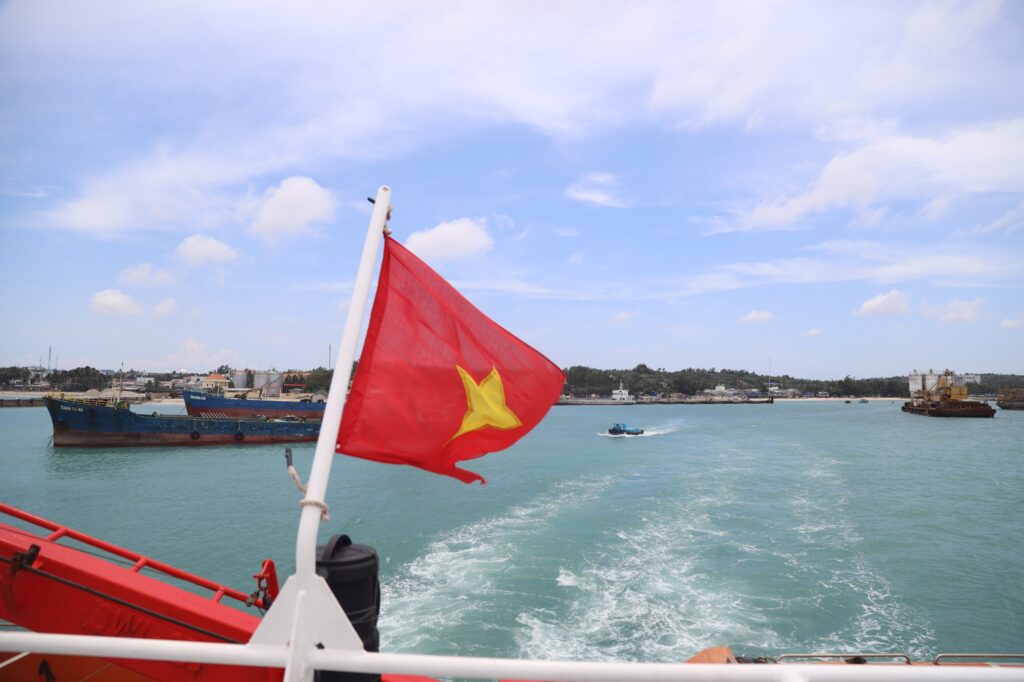Phu Quy Island District is one of the island districts with a diverse range of architectural works, cultural and religious heritage, especially Buddhism, with many temples that are both ancient and modern. The temples on Phu Quy have not only been places of religious and spiritual activities but also serve as shrines honoring soldiers who sacrificed their lives in the cause of protecting the sacred sovereignty of the nation’s seas and islands.
Many locals on Phu Quy Island also say that perhaps in this island sea area, the spiritual world is always an important part of the people’s lives here. In fact, before fishermen go out to sea, they express their sincere prayers and wishes for safe journeys…
According to our statistics, Phu Quy Island District has 7 temples spread across the main island of Phu Quy, including: My Quang, Lien Hoa, Linh Buu, Linh Quang, Linh Son, Long Son, and Thanh Lam. Among them, Linh Quang Temple was established more than 300 years ago, and the newest is Long Son, which was built and put into operation in 1993. All these temples bear distinctly national architecture, exuding tranquility, solemnity, and serenity.
In this article, VETAUPHUQUY.VN has been and continues to update information about the temples on Phu Quy Island. Although it may not be complete yet, we hope our valued readers will receive and support this so we can continue to add more in the future.
Linh Quang Temple – The First Temple on Phu Quy Island
Linh Quang Temple is the pioneering temple associated with spreading the light of Buddhism in Phu Quy. Not only a place with beautiful scenery, Linh Quang Temple is also a representative temple in terms of history, culture, and art on the island.
Linh Quang Temple is located on a hill in My Khe village, Tam Thanh commune, just a few hundred meters from the coast. The temple is surrounded by many trees and large stones engraved with inscriptions documenting Linh Quang Temple’s history.
Linh Quang is an ancient temple famous for its scale as well as religious architecture and rituals. The temple features diverse natural landscapes worthy of being one of Phu Quy’s scenic spots.
According to the temple’s genealogy, the official age dates back to the year Dinh Mao 1747 during the reign of King Le Hien Tong – the 8th year of the Canh Hung era. Initially, it was just a thatched house built by Zen master Nguyen Canh in 1747. At first, it was used for worship and as a residence for monks. After many renovations, by 1992, it became a unique and beautiful architectural complex.
Historical records and information from elderly residents of Phu Quy reveal that originally, the area around Linh Quang Temple was covered with forests and many natural rocks. The temple’s founding master, Nguyen Canh, saw this place as suitable for establishing a temple to worship Buddha, so he built a small hermitage. His purpose was to chant sutras and pray for the safety of fishermen going to sea.
When Lord Nguyen Anh (later Emperor Gia Long) was pursued by the Tay Son army, he fled to Phu Quy Island and stayed at Linh Quang Temple for a while.
After returning to the mainland and ascending the throne, to commemorate his wandering days on the island and leave a memory of visiting Linh Quang Temple, Emperor Gia Long composed a poem on the temple’s terrace, which reads:
“Gia Long fled during the country’s turmoil.
Landing on the twin isles called Linh Quang.
Gazing westward, guarding the sacred place.
Facing west, erecting the great gate.”
At the end of the 18th century, Linh Quang Temple was damaged by fire, and many precious relics were lost. Later, a sacred stone emerged at the strait near Hon Tranh, Phu Quy Island. Seeing this as an auspicious sign, the local Buddhists brought the stone to the temple. Artisans then carved the stone into a statue of Shakyamuni Buddha, 121cm tall and weighing 300kg, which is still worshipped today.
Locals named the place where the sacred stone appeared “Phat Bay” (Buddha Bay). This story has been passed down to descendants to express respect for the Buddha.
Today, Linh Quang Temple is spacious with many impressive ancient features. The main architectural works all face west and are arranged in the shape of the Chinese character “丁” (ding), including the main hall, triple gate, assembly hall, monk’s house, and the watchtower.
In front of the temple stands an ancient tower adorned with exquisitely carved dragons and phoenixes, a special highlight of this ancient temple in the middle of the sea.
Inside the temple is the Great Bell cast in 1795 and the Prajna drum, 1 meter in diameter, made from a single starwood log.
Also present are dozens of ancient inscriptions on plaques and couplets that tell Buddhist legends, praise the Buddha, and guide people towards goodness.
Among the most carefully preserved treasures at Linh Quang Temple is the “Sac Menh Chi Bao” box containing royal edicts from the Nguyen Dynasty given to the temple (2 from King Tu Duc, 1 from King Dong Khanh, 1 from King Duy Tan, and 1 from King Khai Dinh). These five edicts remain intact and are only brought out for major ceremonies.
Linh Quang Temple not only offers beautiful scenery but is also a venue for major festivals. Islanders who work far away always try to return to participate in traditional island festivals such as Tet, Buddha’s Birthday, Vu Lan, and Thanh Minh ceremonies.
As of 2023, Linh Quang Temple is over 276 years old and is one of the oldest temples in Binh Thuan Province.
It was classified as a national scenic spot by the Ministry of Culture and Information (now the Ministry of Culture, Sports and Tourism) under Decision No. 51 QD/BT dated January 12, 1996.
Linh Son Temple, Phu Quy
Linh Son Temple is located on Cao Cat Mountain, the second highest mountain on Phu Quy Island. It is considered the most beautiful architectural complex on the island. According to some locals, Linh Son Temple was restored in the early 20th century.
Since its establishment, the temple has attracted many Buddhists and locals who come to admire and pray for peace and good fortune for their families. Beyond the typical architecture seen in temples nationwide, Linh Son stands out with its picturesque landscape. The fresh and cool atmosphere creates a relaxing feeling for visitors. The ancient temple is surrounded by vast forests of towering trees. The sound of the temple bell echoes softly, mingling with the scent of incense, allowing visitors to escape the mundane world.
With its unique architecture and stunning natural scenery, Linh Son Temple is a must-visit pilgrimage and sightseeing destination for visitors crossing the sea to Phu Quy Island, Binh Thuan.
Not only a pilgrimage site, Linh Son Temple also offers an exciting journey and an opportunity to admire unique natural beauty. Watching the vast ocean waves and majestic mountains in a peaceful place will surely refresh your spirit.
There is no resident abbot here; Buddhists take turns performing rituals and warmly welcoming many visitors who come to explore and relax.
Cao Cat Mountain in northern Phu Quy is one of the island’s two highest peaks and is regarded by locals as sacred. From Long Hai commune, visitors can easily reach the mountain’s base and then walk up stone steps to Linh Son Temple.
The dense forest of towering trees cloaks the ancient temple in deep green hues, adding to its mystical aura. Offshore, the vast blue ocean stretches endlessly.
You can also glimpse fishing villages, fine sandy beaches, winding hills, and scattered roofs. The sounds of wind, waves, and occasional temple bells resonate in the quiet space filled with the faint aroma of incense.
Linh Son Temple is quite spacious with many unique architectural features harmonizing with the natural beauty. This temple plays a vital role in the spiritual life of Phu Quy residents and serves as a spiritual refuge for fishermen praying before going to sea.
After offering incense at the temple, don’t forget to continue up the mountain to admire the majestic statue of Bodhisattva Avalokitesvara seated on a giant stone pedestal. This structure is a special highlight, enhancing the beauty of the Linh Son Temple – Cao Cat Mountain scenic complex.
Nearby, a rocky outcrop overlooks a cactus-covered beach and a deep abyss hundreds of meters below. Gazing afar, you will see a spectacular panorama of sea, sky, mountains, forests, villages, boats, and the bustling Phu Quy port.
All create a unique picturesque landscape. The atmosphere here is fresh and cool, evoking a comfortable and peaceful feeling.
Thanh Lam Temple, Phu Quy
Thanh Lam Temple is located in Quy Thanh village, Ngu Phung commune, Phu Quy district, Binh Thuan province. It is a temple with a history spanning hundreds of years on Phu Quy Island.
Thanh Lam Temple was founded in the first year of Canh Ngo during the Canh Hung era. In 1774, a group of 50 people from Binh Dinh and Quang Nam, who were fishing at sea, were caught in a storm and drifted to this island. Seeing the fertile land and fresh water, they brought their families to settle and established the temple to worship Buddha, entrusting their faith for protection during storms. This marked the founding of Thanh Lam Temple. According to the temple’s annals written in Nom script, besides Thanh Lam Temple, these 50 people also built a shrine to worship Tran Nam Hai, now known as Quy Thanh Mausoleum.
Every year, the temple holds major festivals such as Buddha’s Birthday, the 7th and 10th lunar months, and the first and fifteenth days of the lunar month. These ceremonies attract many Buddhists and island residents to pray for peace and prosperity.
Linh Buu Temple, Phu Quy
Linh Buu Temple is located in Ngu Phung commune, Phu Quy district, founded in 1971 by Venerable Thich Tu Hue from Tra Can Temple, Ninh Thuan, together with Buddhists. The temple lies at the foot of a hill, hidden beneath tree canopies, offering a serene and tranquil setting.
Originally built simply to serve as a place for followers to gather, it included the main hall and a lecture hall. In 1999, followers built a majestic stupa combining Thai and Vietnamese cultural elements to enshrine the remains of Venerable Tuong Kim. Today, Linh Buu Temple has been extensively renovated into a solemn and grand monastery. The main hall is constructed with reinforced concrete, featuring a front courtyard and a tower decorated with exquisite dragons and phoenixes. From afar, the temple appears nestled among ancient trees, intermittently visible, giving visitors a peaceful and transcendental feeling.
My Quang Temple on Phu Quy
My Quang Temple is located in Phu An village, Ngu Phung commune, founded by Dao huu Thuc Dung and Buddhists. It is built on a sand hill next to the Quan Thanh shrine and the Thay’s Mansion, forming a spiritual complex for locals.
Lien Hoa Temple, Phu Quy
Lien Hoa Temple was founded by Venerable Thich Tuong Van while serving as the Yiet Ma Axale and abbot at Linh Son Temple. Nearly 90 years old, after many renovations, Lien Hoa Temple attracts many pilgrims and visitors to Phu Quy Island.
Long Son Temple, Phu Quy
Long Son Temple is located in Long Hai commune, Phu Quy district, Binh Thuan province. While Linh Quang Temple is the first temple built on Phu Quy, Long Son Temple is the newest and the seventh temple on the island.
According to some caretakers, Long Son Temple was established in 1993 and has over 30 years of history on the island.
If you ever visit Phu Quy, be sure to visit these temples to escape the noise and bustle of the city. They will offer you a different, peaceful, and carefree life.



